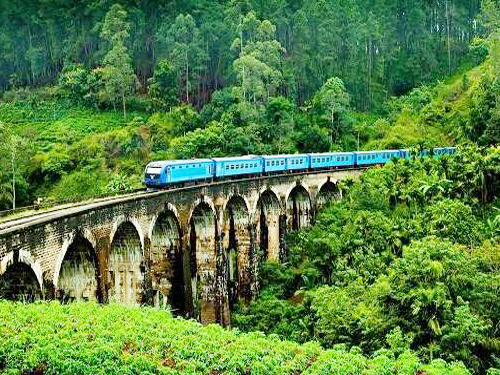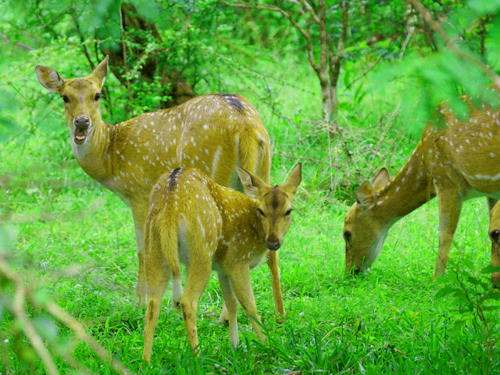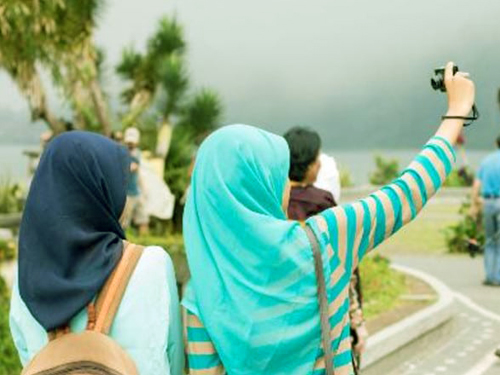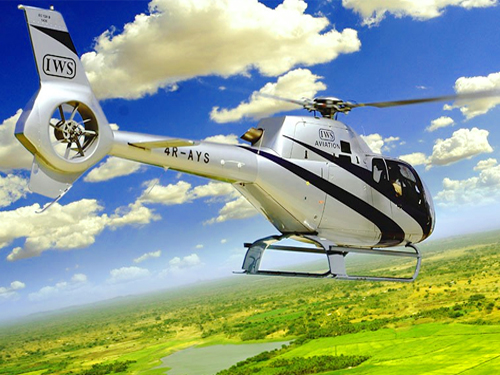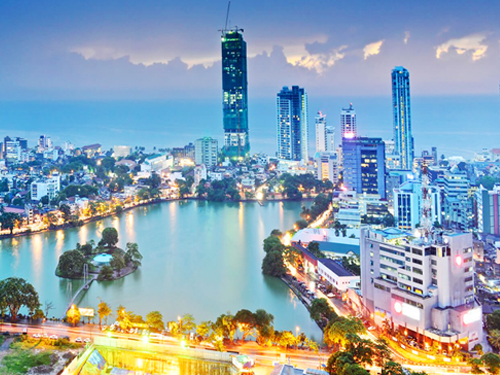Best Location Ramayana Related Places in Sri Lanka
Sri Munneswaram Devasthanam temple, also known as the Munneswaram Temple, is more than a thousand years old. It is an important temple complex in Sri Lanka for Hindus. The complex is located in the village Munneswaram, in the Puttalam District. It includes five temples, including a Buddhist temple. Its central temple is dedicated Shiva, who is one the principal deities of Hinduism. In fact, Munneswaram, one of five coastal kovils dedicated in ancient times to Shiva, is located on the island's perimeter. They are called the Pancha Ishwarams.
The Munneswaram Temple has suffered two major losses during Portuguese occupations in Sri Lanka's history. The temple was destroyed except for its basement in 1578. However, several idols were saved by the locals. The temple was rebuilt by King Rajasinghe I of Sri Lanka. It was then destroyed again by the Portuguese in early 17th century. However, it was rebuilt by locals.
Tourists flock to Chilaw, a nearby fishing and pearling town, to witness the Munneswaram Festival. This four-week-long celebration brings together people of all faiths. Visitors can also visit during the nine-day Navarathri Festival, which celebrates Lord Shiva, and the overnight Sivarathri Festival.
Thiruketheeswaram, also known as the Ketheeswaram Temple, is an ancient Hindu kovil that can be found in Mannar in Sri Lanka's Northern Province. It is one the five Pancha Ishwarams on the island, which are five ancient coastal kovils built around Sri Lanka's perimeter. They were dedicated to the Hindu supreme Being Ishawara, who was the Hindu god Shiva. It overlooks the old Tamil port towns of Manthai, Kudiramalai.
Thiruketheeswaram, which is approximately 2,400 years old is not known the year it was created. It is located alongside the long-buried city Manthottam which was a former Hindu capital and was a hub of international trade during ancient times. The Thiruketheeswaram was destroyed along with many other temples in the country during the Portuguese invasion of the island in the 16th century. Nearly 400 years after its destruction the temple was rebuilt and renovated by the Thirketheeswaram Restoration Society during the 1950s.
There are many legends about the origin of this temple. According to the Indian epic Ramayana the wife of the King of Lanka was from Manthai where her father built Thiruketheeswaram Temple in dedication to Shiva. Skanda Purana is an ancient Sanskrit text that tells the story of the God of Wind removing the three towers from the Maha Meru mountain in Indonesia and dropping one tower at Thiruketheeswaram.
Manavari Temple is a important Hindu Temple in Chilaw, Puttalam district of North Western Province. This Manavari temple is directly linked to the Ramayana Yatra Sri Lanka. The Ramayana Sri Lanka story states that Manavari was the first place where Lord Rama installed the Shiva lingam and prayed it after the victory over king Ravana. According to legend, it is the only lingam named after him and not the one in Rameshwaram (India). These facts are why Manavari Temple Chilaw, a significant hindu temple that is linked to the Ramayana Sri Lanka Yatra, attracts many Indian and local tourists each year.
Ramalingam is the current name of the lingam at Manavari Temple. This lingam was built by Rama. Ramayana's epic depicts Rama as Vishnu's incarnation. A Lingam represents Shiva. Ramalingam is an exceptional object-of-hinduism worship. Only two lingams are named after Lord Rama in the entire world. One is at Manavari Temple, while the other is at Rameswaram in India. This is the most sacred spot in Tamil Nadu.
Ram Setu (or Adam's Bridge) is also known as Rama's Bridge, or Nala Setu. It runs 48 km between Rameswaram Tamil Nadu in India and Mannar Island on the north-western coast. This bridge is a key Ramayana site in Sri Lanka. According to Hindu religious theories and Ramayana, the great Indian Epic, the bridge was built by Lord Rama with his Vanara (monkey army). Surprisingly, the sand dunes can still be seen from above even today. Hanuman built this bridge to allow Rama to cross to Lanka and rescue Sita from Sri Lankan king Ravana.
This is the legendary structure that Vanara Sena built to cross the ocean from India to Lanka. According to the Ramayana Yatra Sri Lanka, Due to global warming and natural calamities, this structure was partially submerged in the late 1400 Ads. This structure can be seen today at 16 locations, including Danush Koti in India or Talai Mannar Sri Lanka. To visit this site, you will need to have special permissions. This bridge is part of Ramayana tour Sri Lanka. It was built by Nala for Rama at the request of Sugreeva the king Vanaras.
Today's controversy surrounds Ramsetu, or Adam's Bridge. It concerns the origins of the famous limestone bridge that connects two countries. A dispute over the origins and meaning of Ram Setu is raging between Hindus, aracheologists, politicians, and NASA of USA. It involves whether the icon is an act by God Ram a or a gift of nature. Ram Setu is just one of 52 Ramayana examples in Sri Lanka. Surprisingly, both the Ramyana story from 5,000 BCE as well as the carbon dating analysis of bridge samples were correctly synchronized. Rama's bridge is thought to have been above the sea level. Historical records also suggest that it was accessible until the 15th century. The area is only 3 - 30 FT deep.
Thirukoneswaram Temple is a medieval Hindu temple complex that is located in Trincomalee, the Eastern Capital of Sri Lanka. It is directly connected to the Ramayana Yatra which is also in Sri Lanka. It is also known by the ThirukonamalaiKonesar Temple, which is the temple of Then Kailasam, Daskina and the thousand pillars. This important Hindu religious pilgrimage site is located in Eastern Province and is a famous Ramayana trail-related site in Sri Lanka. Thirukoneswaram Hindu Temple, located in Trincomalee at the top of Swami Rock Trincomalee is an important Pancha Ishwara Hindu Kovil in Sri Lanka. Other Iswara Temples include Naguleswaram Temple Jaffna and Tondeswaram Temple Matara(Tenavaram), Munneswaram Temple Chilaw, Ketheeswaram Temple Mannar Sri Lanka, and Munneswaram Temple Chilaw.
This temple is located on a rock promontory according to the Ramayana Story in Sri Lanka. It was built by Rishi Agastya at Lord Shiva's instructions. He was inspired by King Ravana's devotion. In the epic of Ramayana, it is said that Lord Rama built this second lingam to remove the Brahmahasthi Dham. This was due to Ravana's malediction of killing him. This temple is believed to have been the site where Lord Rama offered his prayers in order to rid this Dosham. This temple is revered as one of the Pancha Ishwarams Sri Lanka and Ramayana-related sites in Sri Lanka.
Koneshwaram is closely related to the Sri Lanka Ramayana History. The shrine is described in Vayu Purana and the Konesar Kolvettu. Sundarar and Sambandhar are Paadal Petra Sthalam. The famous temple, which was built during the glory era of the Tamil Pallava, Chola and Pandya empires was destroyed by the Portuguese Christian between 1622-1624. The original Kovil, which was built in 205 BC, combined key features to create the basic Dravidian temple plan. This included the Jagati expanses and King Elara Manu Needhi Cholan's thousand-pillared hall, "Aayiram Kal Mandpam". This building is also regarded as one of the most important buildings of its time for its architecture. It features elaborate sculptural bas-relief ornamentation that adorns a black granite megalith, while its multiple gopuram towers with gold plating were extended in the medieval period.
Lover's Leap can be found just a few meters from the main shrine room of the Thirukoneshwaram Hindu Temple. This cliff is extremely deep and rightly situated on the summit at Trincomalee's famous Swami Rock. This place is subject to many interpretations. According to the Ramayana the cliff was made by King Ravana. King Ravana's mother had been a devotee of God Shiva. King Ravana, who was very ill at the time, lifted the shrine rock. Lord Shiva then made him drop his sword. This place was named Ravana Cliff. There is also a love story that Francina van Reed, a young girl from Sri Lanka, jumped from the top rock because she was in a relationship with a Dutch officer during the Dutch Colonial period.
The hot springs of Kanniya are located in the Eastern Province, Trincomalee district of Sri Lanka. The average temperature at these hot springs is 42 Celsius, and each one is slightly different. The popular tourist spot in Trincomalee district is Kanniya hot spring. This hot spring is loved by both local and foreign tourists. This hot spring is currently managed by the Pradeshiya Sabha, Trincomalee's Local Council. This hot water is believed to be good for skin conditions and has healing properties for Arthritis, Rheumatism and Rheumatism.
Inscriptions reveal that hot springs were used by Buddhist Monks, who lived in the area during the Anuradhapura period. The Kanniya Hot Springs site is protected monuments/site by Department of Archeological Sri Lanka. Although there are still some ancient ruins, most were destroyed by the Sri Lankan war in 2009. These wells are believed to have been part of a pond system used by Buddhist monks from Velgam Vehera Buddhist Monastery. A large number of Buddhist buildings has been found around Kanniya hot spring site.
According to King Ravana's era, King Ravana put his sword in many spots on the earth and several fountains rose from these locations. This was the start of hot water springs because the water was boiling hot. This is also a Ramayana Yatra site in Sri Lanka.
Dolukanda, a mountain range in Sri Lanka known for its Dolukanda Raja Maha Viharaya (Dolukanda Buddhist Temple), is thought to be directly connected to the great Indian epic, Ramayana Trail. This mountain is called Dolukada Sanjeewani in the Ramayana. It's located in Kurunegala District. This popular Ramayana site in Sri Lanka is where it is believed that parts of Himalaya Mountain were felt when it was transported to Sri Lanka by Hanuman.
In Hindu mythology, Sanjeewani is a magic herb that has supernatural powers. It is believed to have the ability to heal any disease and grow at night. This mountain, or important site for Ramayana Tour in Sri Lanka, is located in Hiripitiya Village which is approximately 20 km north of Kurunegala district capital.
The Ramayana trail Sri Lanka claims that both Lord Rama (and Lakshman) were severely injured by powerful arrows, and then fell unconscious during Ravana's war against Ravana's army. Sugriva instructed Lord Hanuman to find lifesaving herbs that only grow in Himalayas. Hanuman was said to have carried out the entire Himalayan mountain range from Sri Lanka to find that lifesaving herb, as he was not able to do so alone. It is believed that Himalayan parts fell on five Sri Lankan places. One of these five places, Dolukanda Sanjeewani Mountain, is now considered one Ramayana tourist spot in Sri Lanka.
In Hindu mythology, Sanjeewani is a magic herb that has supernatural powers. It was believed to be growing in darkness and able to heal any disease. This legend also helped to explain the Arankale ancient forest monastery built during the Anuradhapura period.
The "Parumaka Naguliya lena" or the Cobra Hood Cave, is a natural geological formation that forms part of the Sigiriya rocks. Although it is part of the Ramayanatradition there isn't much evidence that anything happened here. Only the inscription, which identifies the cave to be the Naguliya Cave, is a clue. It's a clue to Sita. According to legend, the King of North Indian Vedic city-state Mithila found Sita in a field. Named after the ploughshare which struck her, the name "Naguli", which is very similar to the local term of the ploughshare, was given to her. Naguli might have been her maids' name in Lanka, which would be an equivalent to her real name, but fitting considering the circumstances of her discovery.
This inscription was written here in the Indian Vedic Era, long after the Lankapura Kingdom vanished. It is a significant piece of Sigiriya's history, and there are paintings on the hooded neck that the cobra is supposed to look like.
Sri Bhakta Hanuman Temple, also known as Sri Bhakta Hanuman Temple, is one of the most important Hanuman Temples of Sri Lanka. It is located at the summit of Ramboda's picturesque mountain. The Chinmaya Mission in Sri Lanka built this Hanuman Temple at Ramboda. This temple, Shri Bhakta Hanuman, is dedicated to God Hanuman. It is also a key site of Ramayana Tours in Sri Lanka. The Shri Bhakta Hanuman Temple, Ramboda's tallest Hanuman statue, is open to the public.
In India, the Chinmaya Mission was established by devotees to Swami Chinmayananda, a world-renowned Vedanta teacher. His vision inspired devotees around the globe to form the core of a spiritual revival movement. It now includes a variety of charitable, educational and spiritual activities that enrich the lives of thousands across India and beyond.
The 1999 Hanuman Temple was built. It is believed that Hanuman was looking for Sita Devi. There are still some Ramayana facts in the area, e.g. A village called "Ravana goda" is located near the Bhakta Hanuman Temple. Ramboda, the Tamil term for Ramboda, Rampadai means "Rama’s force". This is why Ramboda is believed be where Rama gathered his troops. It is also believed that this is where Lord Hanuman rested while he searched Sita according to the Ramayana Yatra Sri Lanka.
Traditionally, Hanuman wasn't as popular in Sri Lanka among Tamil devotees than he is today. This was because he destroyed parts of the island using his burning tail. In Sri Lanka, however, Hindu missionaries and Tamil spiritual leaders have begun to build shrines for Hanuman worship.
Ravana took Sita Devi by chariot on the chariot path, also known as Ravana grass pathway. It is located in the jungle at the top of Ramboda Hills along the Kandy-Nuwara Eliya mainroad. This is Sri Lanka's most famous Ramayana site. This barren land is still bare of vegetation. This passage is believed to have been used by King Ravana to show Sitadevi the beauty of his kingdom, as described in the epic Ramayana. Important Ramayana Sites in Sri Lanka include Sita tear pool and Chariot path.
A small pond known as the Sita tear pond can be found along the Chariot Path. The Chariot Path's pond is thought to have been created by Sita Devi's tears. It has not dried up even in severe droughts, as the adjacent rivers have. It is situated on the top of a mountain range in central Sri lanka, which offers spectacular views from 360 degrees. Sita tear pond is also a very important site on the Ramayana tour to Sri Lanka.
The pathway is paved with only grass, which proves the great story of Ramayana. This area is home to many trees with bright red blossoms, which gives the area a bright color. The local villager calls these flowers Sita flowers. These flowers are unique because of their unusual configuration. The stamen, petal and pistil look like a human figure with a bow and could represent Rama. This flower is believed to be unique in Sri Lanka.
Many large trees have bright red blossoms that add a bright color to the landscape. These flowers are called Sita flowers because they are related to Sri Lanka's Ramayana story. These flowers are unique because of their arrangement of stamen, petal and pistil. This is believed to be Rama. This flower is believed to be unique in Sri Lanka.
The route is very difficult and can only be reached by a 4WD vehicle, or an estate tractor. From Labookelle, it takes approximately 2 hours to reach Frotoft tea estate. It is a difficult trek up to the summit and may not suit children, seniors and those with physical disabilities.
Sita Kotuwa, or Sita Matha’s court, is an archeological location that is directly connected to the Ramayana Trail Sri Lanka located in Gurulupotha Hasalaka in Central Province, Sri Lanka. This is an important Ramayana trail Sri Lanka site. Sita Matha's Court is located in a beautiful, remote location, surrounded by streams, waterfalls, and abundant flora, fauna, and streams. There are limestone caves where you can see the remains of an ancient forest monastery dating back to the late Anuradhapura era.
Ramayana facts Sri Lanka reveals that Lankapura was once located in these jungles. A beautiful palace was built for Queen Mandothari, surrounded by streams, waterfalls and a variety of flora. This is where Sita devi, according to the Ramayana trail Sri Lanka, was kept before she was transferred to Ashok Vatika. These are remnants from later civilizations. Sita Kotuwa, which means "Sita’s fortress", connects it with the Ramayana epic story. Its name is a result of Sita Devi's visit here.
According to Ramayana Sri Lanka facts, it is also believed there was an aircraft repair center in King Ravana's capital. According to Valmiki, King Ravana's Vimana looked like a large peacock. In Sinhala language, Vimana means Dhandu Monara, also known as flying peacock. Gurulupotha is a name that refers to parts of birds.
Sita Amman temple in Sri Lanka is the only Hindu Temple dedicated to Princess Sita. This is an important Ramayana-related place in Sri Lanka. Nuwara Eliya is home to the Sita Amman Temple. Sita Eliya is located in Nuwara Eliya Town (10 minutes drive). This Ashoka Vatika was converted into a Hakgala Botanic Gardens, Sri Lanka. Sita Amman temple can be found on the Ramayana Trail Tour Sri Lanka, which runs from Kandy to Ella via Nuwara Eliya.
This soil is dark in colour. According to Ramayana's epic, it is believed that Hanumanji burned this area before leaving Sri Lanka. You can still see the footprints of Lord Hanuman's feet near the stream that runs close to Sita Amman Temple.
Referring to the Ramayana proof Sri Lanka, it is believed that King Ravana kept the Sita devi captive at this location. The stream runs along the temple's side. It was there that Sita Devi ate during her time at Ashok Vatika. This stream is said to have been used by Sita Devi during her stay at Ashok Vatika. Three idols, discovered in the stream around a century ago, were also found there.
There is now a temple for Lord Rama and Sitadevi, Luxshmana and Hanuman at the stream's side. It is fascinating to see that there are foot prints similar to those of Lord Hanuman found along this stream. Some are small while others are large.
Divurumpola, a Buddhist Temple, is located near Welimada (4 KM) along the Nuwara Eliya – Badulla main road in Central Province of Sri Lanka. Divrumpola temple, or Divrumpolaraja Maha Viharaya, is directly linked to the Ramayana Trail in Sri Lanka. According to the Ramayana of Sri Lanka, it is believed that Divurumpola is where Sita went through the fire ordeal Agni Pariksha (or "Agni") to prove her chastity before God Rama saved her. He saved her and she returned home unscathed. These historical facts make Divurumpola one of the most important Ramayana Historical locations in Sri Lanka. Divurumpola in Sinhala is a "Place for oath".
Divurumpola Temple (Raja Maha Viharaya), is a significant religious site for Hindus. It is revered by hundreds of Hindus every day. Divurumpola Raja Maha Viharaya, a Buddhist temple, can be found in the complex with Buddhist stupas as well as sculptures of Buddha. Here are sculptures depicting the Hindu God Rama and Devi Sita as well as Lord Hanuman. Here you can see the Isthreepura Mountain, where Sita was kept captive in a cave castle. This is the Ramayana site in Sri Lanka. This Buddhist Temple is still worshipped by both Buddhists and Hindus in Sri Lanka today. It is also considered a Ramayana Historical Place in Sri Lanka.
Legend Ramayanaya's love story tells that Sita received a message from Rama about his victory over Ravana. She was then taken to Sita on a palanquin and presented with jewels. After such a long period, she was overwhelmed with emotion as she met her husband. Rama was lost in thought. Sita was stunned by the words he spoke. "I killed my enemy. I've done my duty as a true king. You have spent a year in the abode of this enemy. It is wrong that I should take you back now.
Sita Devi replied, "You have broken mine Heart. Only the uncultured can speak like that." Are you forgetting the noble family from which I came? It is Ravana's fault that Ravana took me away by force. My mind, heart, and soul were all fixed on you, my lord!
Ramayanaya facts says that she turned to Lakshmana with tears streaming down her face and asked him to light a fire for her. He lit a large fire and that would be the only way to get rid of this problem. Sita reverently approached her husband, joining her palms in salutation. With these words, she jumped into flames, saying, "If you are pure, fire will save me." Sita invoked Agni from the flames. He raised her from the flames und unharmed, and presented her Lord Rama.
As a sign of respect, a sapling from the Anuradhapura Bodhi Tree was planted. Under the Bodhi tree, a small dagoda (Stupa- or Pagoda-type building) was built. There are paintings depicting stories from Sri Lanka in the Ramayanaya story. This is the second most important Ramayana Yatra site in Sri Lanka, after Ashok Vatika.
The Gayathri Cathedral, also known as Sri-Lankatheeswarar Temple, is the first temple dedicated to Goddess Gayathri. This place was chosen by Gayathri Siddhar because it offered a spiritual revelation. The Tri Moortis, Siva, Brahma, and Vishnu appeared here in the form of Indrajit, the son of an ancient Sri Lankan King Ravana. Gayathri Peedam, therefore, is an important site of Ramayana Tour of Sri Lanka. It is believed that the Tri Moortis - Siva, Brahma, and Vishnu - appeared here when prince Meganath, also known as Indrajit, performed Siva Thapas and Nikumbala Yagna. The Gayathri cathedral is a colonial township, which is located 7,000 feet above the mean sealevel in Nuwara Eliya Eliya Eliya Eliya.
Ashoka Vatika was the location where Sita Devi was held captive under the Sri Lankan King Ravana during Ramayana yatra. It is not clear where Ashok Vatika is located in Nuwara Eliya, but it is believed that the area is in Sita Eliya plus part of the Hakgala Botanic Gardens and Hakgala Strict Nature Reserve. The area around Sita Amman Temple/ Hakgala Botanic Gardens/ Nearby streams and other areas is part of Hakgala
Ashok Vatika, a garden in Lanka, was situated in the kingdom of Rakshasa King Ravana. It is mentioned in the Vishnu Purana, the Hindu epic Ramayana and all subsequent versions. This includes the Ramacharitamanas written Tulsidas. Vishwakarma built the Vatika with his garden houses. It is where Sita, Rama's wife, was taken captive by Ravana. She also refused to stay at Ravana’s palace. Hanuman also met Hanuman here and identified himself with Rama's finger ring.
Ashoka tree (Saraca asoca), also known as Sita Ashok because of its connection to the Ramayana Sita, stayed at Ashok Vatika up until the end the epic battle between Ravana and Rama which saw Ravana and most of his clan being destroyed. Hanuman destroyed a large portion of the Ashoka Vatika when he visited Lanka to search for Sita. The Pramda Van, which was at the heart of the Ashok Vatika, was also destroyed.
It is located in an area called Seetha Eliya close to Nuwara Eliya. It is located at the base the Hakgala Rock forms. The garden has Sita Pokuna. This barren area is atop of the Hakgala Rock Jungle where Sita is alleged to have been held captive. The Sita Amman Temple can be found here. Sita Jharna, a place where Sita was able to bathe in the stream at Sita Eliya is another connected site. This site is closely connected to Hindu theology and has been a focal point of media attention in recent years.
The Ravana falls are found in the hills of Ella, Sri Lanka. They can be found along the road. The water cascades 25 meters from an oval concave stone. Ravana Falls, a three-tiered cascading waterfall that creates rock pools as it descends, is known as Ravana Falls. The Ravana Falls appears as a drooping Areca flower during the wet season, but it is much smaller in the dry season. It's worth visiting this waterfall if you're Ella, as it's one the easiest to access waterfalls in Sri Lanka. Here's all you need to know before you go to Ravana Falls Ella. Ravana falls, also known as Ravana Ella is a popular tourist attraction in Sri Lanka. It is currently ranked as the largest waterfall in the country.
The legendary king Ravana was the inspiration for the name of the falls. This is also connected to the Indian epic, the Ramayana. Legend has it that Ravana, the Sri Lankan king at the time, kidnapped Sita and hidden her in the caves below this waterfall. According to legend, the reason for Sita's kidnapping was revenge for Rama (husband and wife of Sita), and Laxmana (brother). The cave was then surrounded by thick forests, in the middle of the wilderness. Rama was believed to have bathed in the pool where water from this waterfall accumulated. They believe Ravana played the Ravanahatha here.
Ravana Cave can be found approximately 2 km from Ella and 11 km (7 miles) from Bandarawela. It's a small cave measuring approximately 50ft in width, 150ft in length, and 60ft tall. According to legend, King Rawana used the cave to hide Princess Sita. It is located 1,370m (4,490 feet) above sea level, on the foundations of a cliff. This cave is one of the most visited tourist attractions in Sri Lanka and has historical significance.
The Maha Ravana Viharaya is the first stop. Ravana Cave, located just 1 km away, can be reached by climbing up the steep path leading to the cave. It is quite strenuous with approximately 650 steps. Some of the steps are uneven and some are very steep. Other places have no steps or just steep rocks. These last feet are the most difficult because one must climb up without any support. For someone with high expectations, the cave isn't very impressive. It is difficult to climb, and once you get there you will see a small cave.
Panchamuga Anjaneyar Temple is considered the first Anjaneyar Temple of Sri Lanka. This Panchamuga Anjaneyar Temple Sri Lanka is dedicated to Lord Hanuman, in his Panchamuga form. It means five faces. This temple is found in Colombo Sri Lanka. The first Sri Lankan hanuman temple, Sri Panchamukha Ancheneyar temple, was built by Swamy Chandrashekar. Srimath Chandrashekara Swamigal built the First Temple in Sri Lanka, and the first chariot in all of Asia for Sri Rama's devotee Anjaneyar.
1998 The first Anjaneya chariot was launched. After ten days of yaga Pooja Anjaneyar Jayanthi festival, the chariot procession starts at 8:00 AM and ends in the evening at 6:00 PM. Before the chariot festival, pour holy water of Sita Eliya into Nuwara Eliya soil. Then take a twig from the tree and offer it Pooja. Only then can the chariot move from the spot. Hanuman, as his mother's maiden name is Anjan, is commonly called Anjaneyar by Tamils. The chariot festival is usually held at the beginning of January or the end of December. Historical Ramayana Yatra says that Hanuman helped Lord Rama defeat King Ravana. In the Ramayana epic, Lord Shiva assumed the form Hanumanji. This is a Ramayana-related site in Sri Lanka.
Although Kelaniya Buddhist Temple is an important Buddhist Temple in Sri Lanka, Ramayana tour Sri Lanka has a direct connection to Kelaniya Buddhist Temple. Ramayana says that King Vibhishana was crowned after the death King Ravana. Kelaniya was the area that had been ruled over by Vibhishana. Lakshmana crown Vibhishana in Kelaniya because Rama had 14 years of self-exile to fulfill his father's commitment, King Dasarath (of Ayodhya). The Kelaniya Buddhist temple is also an important part of the Ramayana tour to Sri Lanka. King Vibhishana, who supported Rama against his brother's injustice, was considered fair.
It is often associated with the rise and decline of Ceylon/Srilanka. There has been a popular saying that the Kelaniya temple raised Sri Lanka and the country fell. The temple has been closely associated with the political power of the country.
The Temple also known for the image of the reclining Gautama Buddha as well as paintings by Solias Mendis, a native artist, which depict important events in Buddha's life, and also incidents from Jataka stories. The Duruthu Maha Peruhera procession takes place here each January. The temple is home to an 18-foot tall stone statue representing the Bodhisattva Avalokitesvara.

 Safe Travels
Safe Travels Français
Français Deutsch
Deutsch עִברִית
עִברִית Italiano
Italiano Nederlands
Nederlands Polski
Polski Pусский
Pусский Español
Español



